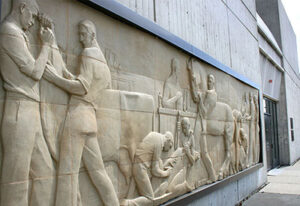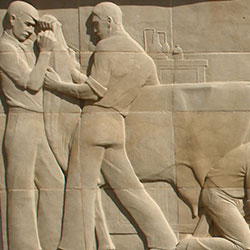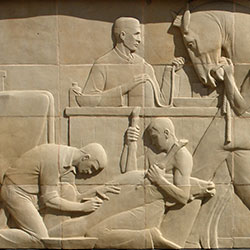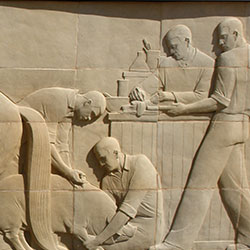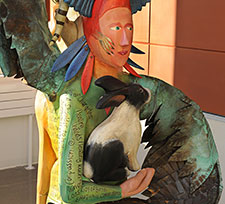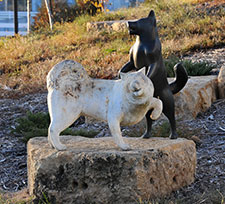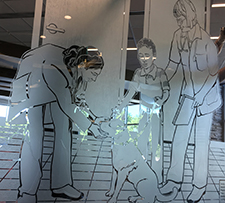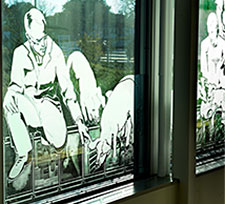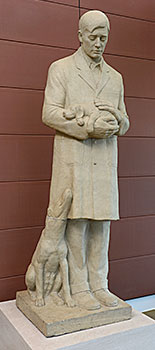
The College of Veterinary Medicine is home to the most recognized sculpture and most visited works of ISU’s renowned “sculptor in residence,” Christian Petersen. Since their completion more than 60 years ago, The Gentle Doctor and The Veterinary Medicine Mural (bas relief) have been recognized throughout the U.S. and the world as symbols of veterinary medicine.
Much of the information about sculptor Christian Petersen and his works for the College of Veterinary Medicine is excerpted from the book Christian Petersen Remembered, written by Patricia Lounsbury Bliss, ISU Press, 1986.
See also: University Museums’ Web site on Christian Petersen.
The Gentle Doctor sculpture, as described by Dr. Frank K. Ramsey: “The Gentle Doctor… reflects concern, affection, love, and the significance of life for all of God’s creatures – great and small.”
The statue was created in heroic, larger-than-life proportions — it is seven feet tall. But there is a reason why Petersen incorporated large hands and feet. He understood that veterinarians stand on their feet all day, so the feet have to be big and strong. And as for the hands — hands are the veterinarian’s most important examining tools.
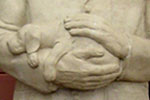
The tall, capable doctor gently holds an injured or ailing puppy while glancing down to catch the watchful gaze of the mother dog. The mother dog leans against the gentle doctor’s knee, patiently waiting at his feet.
On both the original and the bronze versions of The Gentle Doctor, the puppy noses have been worn smooth by thousands of persons who instinctively reach out to bestow a reassuring touch. Christian Petersen’s sculpture evokes our human compassion for all animals, particularly our companion animals.
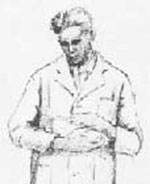
The idea of The Gentle Doctor began in 1936 when Christian Petersen was sketching a central figure to enhance the bas relief mural he was creating for the courtyard wall of the Veterinary Quadrangle. Some have speculated that the statue became a way to memorialize the dean of Veterinary Medicine, Charles H. Stange (*note on Stange, below), who had died suddenly of a heart attack in April 1936.
Beginning in 1938, the sculptor’s studio was moved to an empty equine ward in the southwest corner of the veterinary quadrangle. It was here that a special rapport developed between the artist and veterinary students and faculty. Several students served as models for various stages of the sculptor’s work.

Perhaps it was pre-ordained that aspiring veterinarians would be linked to the Danish-born sculptor. In 1936, while Petersen’s studio was in the home economics building, he met a freshman pre-vet student who was earning his way through school by doing janitorial work. The student, L. M. Forland, would go on to graduate in veterinary medicine in 1941, but first he assisted Petersen as a model for what became known worldwide as The Gentle Doctor.
Dr. Forland later explained the setting for author Patricia Bliss.
“It was the latter part of ’36 and the early part of winter quarter ’37 that I modeled for Christian Petersen… Mr. Petersen often worked in the late afternoons and evenings when I was there, and we became good friends….I remember too well how heavy his garbage cans were!
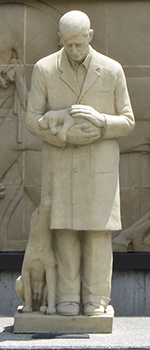
…If we had a few minutes’ time, he would ask me to stand for him while he carved away at a small pile of clay. He had me hold a small pillow between my forearms in a position similar to that of a little pup.”
That pillow or ‘little pup’ became the focal point of Petersen’s statue. It represents the bond between people and animals, symbolizing the essence of veterinary medical practice.
The original terra cotta statue, The Gentle Doctor, was installed in 1938. For nearly four decades it remained outdoors in front of the Veterinary Medicine Mural. In 1976 the College of Veterinary Medicine moved out of the veterinary quadrangle and into a new complex at the south edge of campus.
As a gift to the College, Dr. and Mrs. John E. Salsbury had a replica of The Gentle Doctor cast in bronze for placement as the focal point on the entrance plaza for the College. The original terra cotta statue was refurbished and placed in a more protected setting inside the Scheman Building at the Iowa State Center before being moved to the lobby of the Hixson-Lied Small Animal Hospital in 2012.
*Charles Stange had become dean of the Division of Veterinary Medicine in 1909 at the age of 28. He was a pioneer in developing education for a new kind of graduate in veterinary medicine. He emphasized science and a rapidly emerging technology that applied to both human and veterinary medicine. This educational philosophy was impressed upon Christian Petersen, whose works reflected that message, emphasizing the symbiotic relations between humans and animals.

